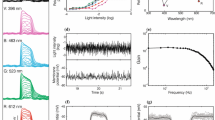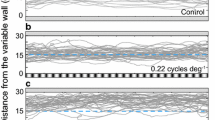Summary
Whether or not colour discrimination is involved in the process of eliciting the landing response of the fly was investigated with rotating linear spiral patterns of different spectral composition. With monochromatic patterns execution of the response depends on the contrast in the pattern: no response occurs within a restricted range of intensity ratios corresponding with low pattern contrast. With dichromatic patterns execution of the response depends on the intensities of the two spectral components (which each dominate half the pattern). No response occurs within a restricted range of intensity ratios; this range characteristically depends on the spectral wavelengths in the pattern. The mean values of these ranges are used to determine a spectral sensitivity distribution of the landing response.
In an alternative procedure the spectral sensitivity was obtained from threshold intensities of a high contrast spiral pattern superimposed on a constant background. The spectra obtained by the two methods are very similar broad-band curves with peaks in the UV and in the blue-green. At the intermediate and low intensity range the contrast thresholds are slightly dependent on the intensity.
Taken together the results suggest that with moving stimuli colour discrimination is absent in the landing response pathway. What is processed are just contrast differences determined by intensity and spectral wavelength.
Similar content being viewed by others
References
Braitenberg VB, Taddei Feretti C (1966) Landing reaction ofMusca domestica. Naturwissenschaften 53:155
Burkhardt D (1962) Spectral sensitivity and other response characteristics of single visual cells in the arthropod eye. Symp Soc Exp Biol 16:86–109
Coggshall JC (1972) The landing response and visual processing in the milkweed bugOncopeltus fasciatus. J Exp Biol 57:401–413
Daumer K (1956) Reizmetrische Untersuchungen des Farbensehens der Bienen. Z Vergl Physiol 38:413–478
Dörrscheidt-Käfer M (1972) Die Empfindlichkeit einzelner Photorezeptoren im Komplexauge vonCalliphora erythrocephala. J Comp Physiol 81:309–340
Eckert H (1980) Orientation sensitivity of the visual movement detection system activating the landing response of the blowflies,Calliphora andPhaenicia: A behavioural investigation. Biol Cybern 37:235–247
Eckert H, Hamdorf K (1980) Excitatory and inhibitory response components in the landing response of the blow-flyCalliphora erythrocephala. J Comp Physiol 138:253–264
Eckert H, Hamdorf K (1982) Contrast frequency dependence. A criterion for judging the non-participation of neurons in the control of behavioural responses. J Comp Physiol 145:241–247
Eckert H, Fligge B, Hamdorf K (1979) Excitation and inhibition in the activation of the landing response of the blowfly,Calliphora. Naturwissenschaften 66:368–370
Fernandez Perez de Talens A, Taddei Feretti C (1970) Landing reaction ofMusca domestica: dependence on dimension and position of the stimulus. J Exp Biol 52:233–256
Fischbach KF (1981) Habituation and sensitization of the landing response ofDrosophila melanogaster. Naturwissenschaften 68:332
Franceschini N, Kirschfeld K (1971) Les phénomènes de pseudopupille dans l'œil composé deDrosophila. Kybernetik 9:159–182
Goodman LJ (1960) The landing responses of insects. I. The landing response of the flyLucilia sericata and other Calliphorinae. J Exp Biol 37:854–878
Goodman LJ (1964) The landing responses of insects. II. The electrical response of the compound eye of the flyLucilia sericata upon stimulation by moving objects and slow changes of light intensity. J Exp Biol 41:403–415
Hardie RC (1977) Electrophysiological properties of R7 and R8 in dipteran retina. Z Naturforsch 32c:887–889
Hardie RC (1979) Electrophysiological analysis of fly retina. I. Comparative properties of R1–6 and R7 and R8. J Comp Physiol 129:19–33
Hardie RC, Franceschini N, McIntyre PD (1979) Electrophysiological analysis of fly retina. II. Spectral and polarization sensitivity in R7 and R8. J Comp Physiol 133:23–39
Heisenberg M, Buchner E (1977) The role of retinula cell types in visual behaviour ofDrosophila melanogaster. J Comp Physiol 117:127–162
Helversen O von (1972) Zur spectralen Unterschiedsempfindlichkeit der Honigbiene. J Comp Physiol 80:439–472
Horridge GA, Mimura K (1975) Fly photoreceptors. I. Physical Separation of two visual pigments inCalliphora retinula cells 1–6. Proc R Soc Lond [Biol] 190:211–224
Kaiser W (1968) Zur Frage des Unterscheidungsvermögen für Spektralfarben: Eine Untersuchung der Optomotorik der königlichen GlanzfliegePhormia regina Meig. Z Vergl Physiol 61:71–102
Kaiser W (1975) The relationship between visual movement detection and colour vision in insects. In: Horridge GA (ed) The compound eye and vision of insects. Clarendon Press, Oxford, pp 359–377
Laughlin SB, Hardie RC (1978) Common strategies for light adaptation in the peripheral visual system of fly and dragonfly. J Comp Physiol 128:319–340
McCann GD, Arnett DW (1972) Spectral and polarisation sensitivity of the dipteran visual system. J Gen Physiol 59:534–558
Meffert P, Smola U (1976) Electrophysiological measurements of spectral sensitivity of central visual cells in the eye of the blowfly. Nature 260:342–344
Razmjoo S, Hamdorf K (1976) Visual sensitivity and variation of total photopigment content in the blowfly photoreceptor membrane. J Comp Physiol 105:279–286
Smola U, Meffert P (1979) The spectral sensitivity of the visual cells R7 and R8 in the eye of the blowflyCalliphora erythrocephala. J Comp Physiol 133:41–52
Stark WS, Ivanyshyn AM, Greenberg RM (1977) Sensitivity and photopigments of R1–6, a two-peaked photoreceptor inDrosophila, Calliphora andMusca. J Comp Physiol 121:289–305
Steiner G (1942) Eine Zuchtweise für Fleischfliegen. Zool Anz 138:97–106
Taddei-Feretti C, Fernandez Perez de Talens A (1973) Landing reactions ofMusca domestica. III. Dependence on the luminous characteristics of the stimulus. Z Naturforsch 28c:568–578
Taddei-Feretti C, Fernandez Perez de Talens A (1973) Landing reactions ofMusca domestica. IV. A. Monocular and binocular vision. B. Relationship between landing and optomotor reaction. Z Naturforsch 28c:579–592
Wagner H (1982) Flow-field variables trigger landing in flies. Nature 297:147–148
Wehrhahn C, Hausen K, Zanker J (1981) The landing response of the housefly (Musca) as driven by motion of a flow field. Biol Cybern 41:91–99
Author information
Authors and Affiliations
Rights and permissions
About this article
Cite this article
Tinbergen, J., Abeln, R.G. Spectral sensitivity of the landing blowfly. J. Comp. Physiol. 150, 319–328 (1983). https://doi.org/10.1007/BF00605021
Accepted:
Issue Date:
DOI: https://doi.org/10.1007/BF00605021




